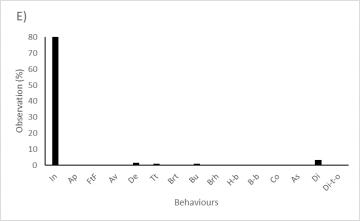Sampling Effort
During the three months of data collection, we made 20 independent recordings of whale and dolphin behaviours. Of these six took place in November, eight in December and six in January (Table 4). In total, 70 hours were spent searching for cetaceans and observing them, covering in the three months a total of 800 nautical miles
Total boat interaction behaviours for all species



We summed up all behaviours for each species observed and calculated the relative frequency for each behaviour. Different species react differently when the boat approaching from performing the whole behavioural range like Stenella attenuata, to performing just 2 behaviours like Physeter macrocephalus.
Accumulation factor

We observed a negative correlation between the percentage of face to face and the date of the encounter (representing the timeline from low tourist season and high tourist season). Regarding the case of Tursiops truncatus the correlation was not faound to be significant but in Stenella attenuata, We obtain a p-value of 0.002.
Distress behaviours

We calculated the proportion of each “distress” behaviour to the total. As can be seen from the bar chart, in both species tail tapping was the most prominent distress behaviour. Breach and breach bomb were not present in the distress display of Tursiops truncatus, but both were present in Stenella attenuata.
Responsible for this page:
Director of undergraduate studies Biology
Last updated:
05/17/18
